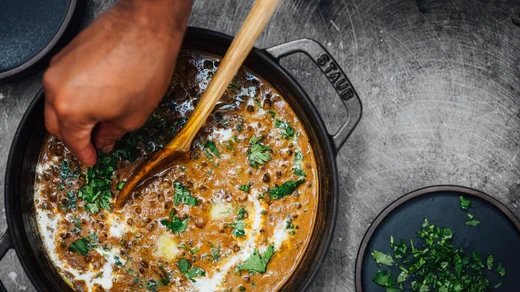Dal Makhani

COMMENTS
-
Bella on
Where can you purchase urad beans?
This site has limited support for your browser. We recommend switching to Edge, Chrome, Safari, or Firefox.
FREE shipping on orders of $50 or moreFREE shipping will be applied at checkout
Spend $50 more for FREE shipping!FREE shipping will be applied at checkout
Sorry, looks like we don't have enough of this product.



By Nik Sharma
Rated 5.0 stars by 1 users
By Nik Sharma
4-6
Excerpted with permission from The Flavor Equation: The Science of Great Cooking Explained + More Than 100 Essential Recipes (Chronicle Books, 2020) by Nik Sharma. Text and photographs copyright © 2020 by Nik Sharma.
In India, the word dal is an all-encompassing term that includes not only the dish but also lentils and some beans. Dal is a staple in many Indian homes across the world; it’s easy to make, comforting, and a great source of protein. One of the things I love about dal is that regardless of the lentil or bean you cook it with, it’s a blank slate for flavor. You can use my simple flavor guide to build and layer flavors into your own dal recipes at home; feel free to tweak it and make your own combinations of flavors. Technically, urad dal is not a lentil but the bean of the Vigna mungo plant, sometimes sold as black gram. You will need to plan a day in advance to soak the beans.
THE FLAVOR APPROACH
Presoaking provides several benefits. The seeds soften and plump up to almost twice their original volume, and their chemical composition changes. The amount of sugars and starches decreases, which helps with cooking, palatability, and digestion.
Adding baking soda to the beans softens the fiber by acting on the pectin and hemicellulose and drastically reduces the cooking time, from several hours to 30 to 45 minutes. Use filtered water if you live in an area with hard water or it might take a bit longer to cook.
Dal makhani is one of the creamiest dals; it leaves a luxurious texture on your tongue imparted by the cream and butter but also by the soft beans. For an extra-rich flavor, top the dal with a few small dabs of salted butter before you add the garnish.
This comfort food contrasts pleasingly with plain rice or flat bread like paratha, and yogurt or raita on the side provide cool contrast.
This dal is special because it gets it unique fiery flavor from the large amount of garlic and ginger used; if you prefer a milder dose of heat, reduce their quantities by half. The hint of cayenne in this dal adds a third note of heat.
The dhungar method of smoking utilizes the principle of smoking fat and infusing it into food by entrapping the smoke in a small enclosed space.
1/8 teaspoon baking soda
1 teaspoon Oaktown Spice Shop garam masala
½ teaspoon ground turmeric
¼ teaspoon cayenne powder
OPTIONAL
The Dhungar Method
This method is used by some to add a smoky aroma to the dal (and other dishes). Do this after the cream is added to the dal, then proceed with fried ginger step. Don’t forget to switch the stove off while doing this.The density of the dal will keep the onion or bowl afloat, and it won’t sink.
Ingredients:
A small, shallow metal bowl or a medium onion, hollowed out in the center
1 to 2 in (2.5 to 5 cm) piece charcoal
1 tablespoon ghee
Directions:
Place the metal bowl or onion in the center of the dal. Using a pair of tongs, burn the charcoal over a flame until it turns red hot. Carefully place the live charcoal in the center of the bowl and drop the ghee on the hot charcoal. It will start to smoke.
Cover the saucepan with a lid to trap the smoke and let it sit for 5 minutes. Remove the lid, the wire rack (if using), and the bowl or onion and safely discard the charcoal. Proceed with the fried ginger in the recipe.

Where can you purchase urad beans?



Hi Bella,
If you’re local to the Bay Area, I would recommend stopping by Vik’s Market in Berkeley. Otherwise, I would search for a local Indian market near you, or purchase them online.
Warmly,
Evan (they/them)
Customer Success Lead
Oaktown Spice Shop